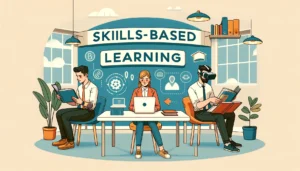Attracting talent across the generation gap
- 7 Min Read
As the way we work continues to evolve and the workforce becomes more diverse, organisations must meet the demands of each generation if they are to attract and retain the best talent across all age groups. Chris Kerridge, employee engagement expert, MHR, shares his top tips on how to do this.
- Author: Chris Kerridge
- Date published: May 22, 2019
- Categories

The UK workforce has undergone significant change in the past ten, twenty years.
The increase in the state pension age has meant that people are working for longer. As a result, the workforce demographic is the broadest it has ever been, comprising baby boomers at one end of the spectrum and digital natives at the other, each generation having their own demands and expectations from their employers.
At the same time, advances in digital technology have also transformed the way that work is carried out, with the lines between work and leisure continually blurring. The traditional 9-5 working day is no longer the norm and has been replaced by more flexible and remote working practices as smartphones and mobile internet access have made it easier for people to carry out work wherever and whenever they want.
Get the process right
Recruitment is a two-way process, with your organisation in the shop window just as much as the candidate. To attract top talent, ensure that the recruitment lifecycle is slick from start to finish and make the most of technology.
Modern HR software solutions speed up the process and automate repetitive tasks. Recruits don’t expect to wait around for responses to applications and emails. Deliver personalised communication through a short process, that allows them to celebrate with you quickly, or move on if they are not the right match.
Remember that the smallest details can be the difference between a candidate accepting an offer or looking elsewhere. From the way your job ad is written to the interview itself, make sure your organisation shines at each stage of the process.
Get your digital house in order
You can be sure that most employees today will be digital-savvy, with millennials now the largest generational group in the workplace. In turn, you need to be sure that the digital experience you offer meets their expectations.
For example, ‘pimp out your portal’ and streamline your process; include engaging multi-media content about your company and real life examples of how the people working for you at the moment have had an experience that will be tough to match for the rest of their career! Your website and online application process is typically the first experience candidates will have of your business – make sure it’s a good one!
Create a vibrant culture
The days of a ‘job for life’ are over. Employee loyalty and predictable career paths are decreasing as globalisation and the ‘information age’ have created conditions for constant change.
New ways of working have rendered the traditional employee/employer contract (long-term service rewarded by predictable progression) outdated, while employees are less likely to have long careers with one employer but rather ‘tours of duty’ working on projects.
With 46% of the workforce expected to be made up of millennials by 2020, organisations must adapt to retain their best employees and establish a company culture that meets their personal expectations and lifestyles.
To achieve this organisations need to make work more meaningful and fulfilling – providing a personalised employee experience (regardless of age) centred on their differing needs, from their development, preferred ways of working, through to benefits which will result in happier, more engaged (and ultimately productive) people who will likely stay at an organisation for longer.
Having a strong business culture, wrapped around a clear set of values, helps ensure that all employees are brought in to your organisation’s direction – and that the right candidates will be eager to jump on board.
Make sure the values that underpin your organisation are available for all to see. Having a set of well-defined values will ensure that everyone at your organisation is reading from the same page, and can be used as guidelines for assessing candidates during the recruitment process.
Offer something different
These days, candidates expect more than just a decent salary. To attract and retain the best and brightest you’ll need to offer a generous benefits package that adds real value to their lives. More than just the standard offering of pension contributions and private health insurance, your offering should be designed to make your employees lives easier, healthier and more enjoyable.
For example, you could offer free mindfulness courses to help combat work-related stress, access to financial advisors to help your staff better manage their money, or provide flexible benefits that allow each individual to pick something that suits their needs. This, along with flexible working options, shows candidates that you care about their lives outside of work.
Recruit from within
With talent in higher demand than ever, it’s easy to miss the gems right under your nose. Searching your existing talent pool for upcoming talent has numerous benefits: it promotes employee engagement and loyalty, helps strengthen your organisation’s culture and values, and saves time and money compared with searching externally. Great HR software will help to identify employees that are ideal candidates for progression – making your job wayyy easier.
Don’t forget: being known as an employer that recruits from within will also act as a big selling point to candidates, who will know that their career development is in safe hands.
Put engagement at the heart of your strategy
Organisations are finally waking up to the fact that an engaged workforce is good news for everyone. To attract and retain the best candidates, make sure that employee engagement is at the heart of your HR and talent management strategy.
When making key business decisions, ask yourself the following question: will this decision improve employee engagement? If the answer is no, you risk losing your most valuable asset: your people. Ultimately, if your people are happy, your business will thrive.
Get creative
If you are looking to find a certain type of talent, your attraction method must match and you can get really creative here. If your talent pipeline needs creative types, use an off-the-wall campaign to really grab their attention and communicate to them in a way that resonates. Don’t forget that ‘scouting’ can be a great way of finding talent that has the edge you are looking for.
So that’s our 7 methods to ensure you come out on top in the war for talent. It can all be made easier with the right HR platform to support your employee lifecycle – from onboarding to offboarding (and everything in-between).
What do workers want, and does this vary by age?
Where once a great place to work was defined by a good salary, prospect for career progression and the prestige that was attached to working for a high profile brand or in a state of the art office, today employees are no longer prepared to stick around if the work itself isn’t fulfilling and meets their lifestyle needs on a day to day basis.
In a recent YouGov survey commissioned by MHR we aimed to establish what makes people happy in their job.
The answers we received varied wildly, from employees who were passionate about their employment and employer in equal measure, to those making impassioned, negative comments, full of colourful language; but lacking in optimism. One thing was clear though – out of the group that were satisfied with work, 63 percent said they were given the flexibility and support to do their job, which really shows how important it is to look after your people.
Looking at the results in more detail, we found that many employees cited flexible hours and the freedom to manage their own working time as important factors in job satisfaction. Other factors included regular meetings and having understanding managers, showing support and freedom are the main components of satisfaction.
A further complication in this age of constant disruption is the varying age diversity and expectation of the workforce.
Today’s professionals are working longer than their predecessors, meaning for the first time that the average workforce is now made up of four generations.
To help engage workers of all ages, it’s important to understand what they want from their career and your workplace.
A recent survey from CV-Library explored the career priorities of UK professionals, revealing their top priorities and how these differ across the generations. The table below outlines the differences:
It’s clear from the data that salaries are important to most professionals. But, different age groups place emphasis on other factors, such as progression, workplace friendships and company culture.









